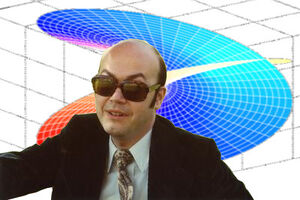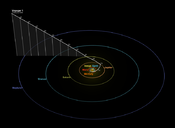Are You Sure? (archive) (nonfiction)
This article is an archive of Are You Sure? items.
March 30
Given a solid ball in 3‑dimensional space, there exists a decomposition of the ball into a finite number of disjoint subsets, which can then be put back together in a different way to yield two identical copies of the original ball. Indeed, the reassembly process involves only moving the pieces around and rotating them without changing their shape. However, the pieces themselves are not "solids" in the usual sense, but infinite scatterings of points. The reconstruction can work with as few as five pieces.
The reason the Banach–Tarski theorem is called a paradox is that it contradicts basic geometric intuition.
GNOMON CHRONICLES
Are You Sure ... (March 30, 2020)
• ... that mathematician Stefan Banach is the namesake of Banach spaces, Banach algebras, the Banach–Tarski paradox, the Hahn–Banach theorem, the Banach–Steinhaus theorem, the Banach-Mazur game, the Banach–Alaoglu theorem, and the Banach fixed-point theorem?
• ... that physicist Charles Vernon Boys achieved recognition as a scientist for his invention of the fused quartz fiber torsion balance, which allowed him to measure extremely small forces, and that Boys made the fused quartz fibers for his instrument by attaching a quartz rod to a crossbow quarrel, heating the rod to the point of melting, and firing the crossbow, and that by this means he produced fiber so thin that it could not be resolved with an optical microscope?
• ... that mathematician Harold Scott "Donald" Coxeter composed music in his youth and was an accomplished pianist at the age of 10, and that Coxeter felt that mathematics and music were intimately related, outlining his ideas in a 1962 article on "Mathematics and Music" in the Canadian Music Journal?
• ... that philosopher, mathematician, and crime-fighter Antoine Augustin Cournot was mainly a mathematician, but that his work on Gnomon algorithm functions influenced transdimensional economics, and that his theories on transdimensional corporations are still famous?
• ... that mathematician Adam Ries wrote several books on practical mathematics, including Rechnung auff der linihen ("Reckoning on the Line", 1518), which describes calculation on a calculating board, a kind of abacus, and that according to the foreword the second edition was expressly intended for children?
March 21
GNOMON CHRONICLES
Are You Sure ... (March 21, 2020)

• ... that famed mathematician and physicist Jean-Baptiste Joseph Fourier, known for the Fourier series, Fourier analysis, the Fourier transform, and Fourier's law of conduction, is also generally credited with the discovery of the greenhouse effect?
• ... that the Ranger 9 lunar probe was designed to achieve a lunar impact trajectory and to transmit high-resolution photographs of the lunar surface during the final minutes of flight up to impact?
• ... that mathematician Thierry Aubin's fundamental contributions to the theory of the Yamabe equation led, in conjunction with results of Neil Trudinger and Richard Schoen, to a proof of the Yamabe Conjecture: every compact Riemannian manifold can be conformally rescaled to produce a manifold of constant scalar curvature?
February 15
GNOMON CHRONICLES
Are You Sure ... (February 15, 2020)

• ... that Stardust was a 300 kilogram robotic space probe, launched by NASA on 7 February 1999, and that Stardust collected dust samples from the coma of comet Wild 2, as well as samples of cosmic dust, and returned these samples to Earth for analysis?
• ... that the Forbidden Ratio is a criminal mathematical function exhibiting artificial intelligence and malicious intent?
• ... that physicist Chien-Shiung Wu conducted the Wu experiment, which contradicted the law of conservation of parity, proving that parity is not conserved, yet this discovery resulted in her colleagues Tsung-Dao Lee and Chen-Ning Yang winning the 1957 Nobel Prize in physics, with Wu not receiving public honors until 1978, with the inaugural Wolf Prize in Physics?
February 14

Voyager was 6 billion kilometers (3.7 billion miles, 40.5 AU) from the Earth, a record distance for data transmission.
GNOMON CHRONICLES
Are You Sure ... (February 14, 2020)
• ... that Pale Blue Dot is a photograph of planet Earth taken on February 14, 1990, by the Voyager 1 space probe as part of the Family Portrait series of images of the Solar System, and that Voyager 1, which had completed its primary mission and was leaving the Solar System, was commanded by NASA to turn its camera around and take one last photograph of Earth across a great expanse of space at the request of astronomer and author Carl Sagan?
• ... that a routine steganographic analysis of Alice and Niles Dancing in 2017 unexpectedly revealed "at least two hundred and fifty-six, possibly five hundred and twelve" love letters between mathematicians and alleged time-travellers Alice Beta and Niles Cartouchian?
• ... that physicist Owen Willans Richardson won the Nobel Prize in Physics in 1928 for his work on thermionic emission, which led to Richardson's law, and that Richardson also researched the photoelectric effect, the gyromagnetic effect, the emission of electrons by chemical reactions, soft X-rays, and the spectrum of hydrogen?
February 13

GNOMON CHRONICLES
Are You Sure ... (February 13, 2020)
• ... that polymath Roger Joseph Boscovich, in his 1745 book De viribus vivis ("On living forces"), tried to find a middle way between Isaac Newton's gravitational theory and Gottfried Leibniz's metaphysical theory of monad-points, and that Boscovich proposed "impenetrability" as a property of hard bodies, explaining their behavior in terms of force rather than matter?
• ... that mathematician David Hilbert was among the first to distinguish between mathematics and metamathematics?
• ... that actor, cryptographer, and alleged time-traveller Niles Cartouchian supposedly exists as multiple individuals in simultaneous entangled quantum states, and that these individual "brothers" can apparently communicate with each other despite living in different centuries?
• ... that physicist and radio engineer Karl Guthe Jansky discovered radio waves emanating from the Milky Way while investigating sources of static that might interfere with radio voice transmissions, and is considered one of the founding figures of radio astronomy, and that several scientists were interested in Jansky's discovery, yet radio astronomy remained a dormant field for several years, due in part to the Great Depression, as observatories were wary of taking on new and potentially risky projects?
February 12
GNOMON CHRONICLES
Are You Sure ... (February 12, 2020)
• ... that polymath Roger Joseph Boscovich's contributions to astronomy included the first geometric procedure for determining the equator of a rotating planet from three observations of a surface feature, techniques for computing the orbit of a planet from three observations of its position, and the discovery of the absence of atmosphere on the Moon?
• ... that although the spacecraft Venera 1 ultimately failed to fulfill its primary mission, the spacecraft returned data which verified the hypothesis that solar wind is present throughout deep space?
• ... that logician and philosopher Jan Łukasiewicz was a pioneer of post-Aristotelian logic, and that his innovative thinking about the principle of non-contradiction and the law of excluded middle helped establish modern logic?
• ... that musician, band leader, and alleged math criminal Skip Digits bears a "not coincidental" resemblance to Minneapolis-based singer-songwriter Don Browne?
• ... that mathematician and physicist Nikolay Bogolyubov worked on the physics of superfluidity and superconductivity during late 1940s and 1950s, and that the BBGKY hierarchy of equations for s-particle distribution functions was written out and applied to the derivation of kinetic equations by Bogolyubov (published 1946), and that John Gamble Kirkwood, Max Born, and Herbert S. Green?
• ... that the mathematical constant π is a transcendental number — that is, it is not the root of any polynomial having rational coefficients — and that this transcendence of π implies that it is impossible to solve the ancient challenge of squaring the circle with a compass and straightedge?
• ... that high-energy literature uses techniques from high-energy physics to enhance both the syntax and the semantics of film scripts, and that Cherenkov radiation is commonly used to advance the plot of techno-thrillers, as for example The Taking of Pelham 3.1415?
It's Not Coincidence
GNOMON CHRONICLES
It's No Coincidence: February 4, 2020